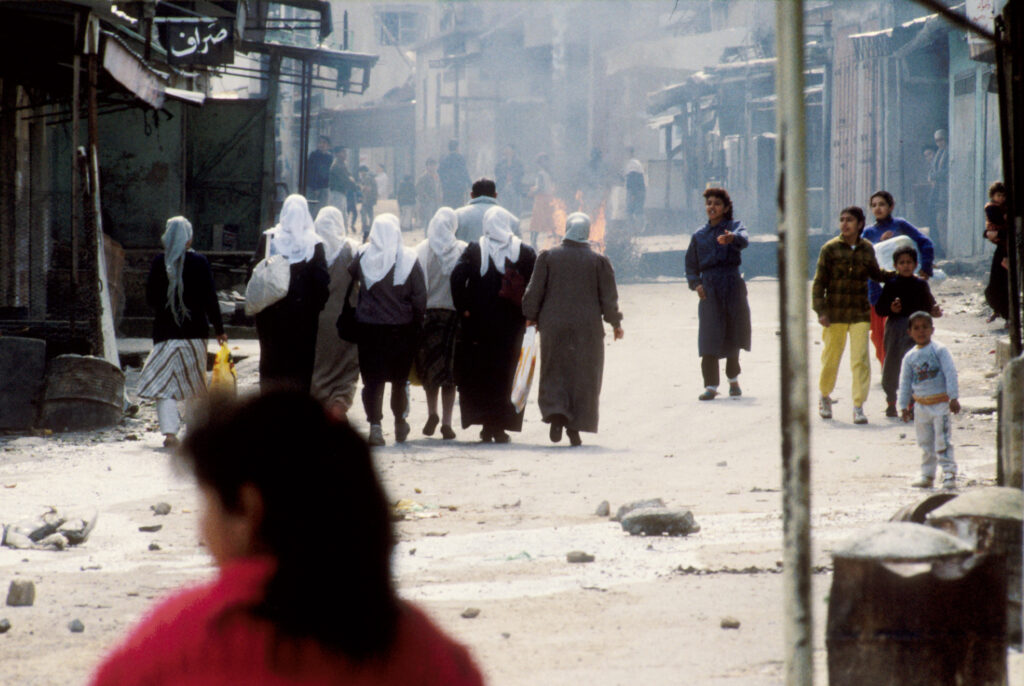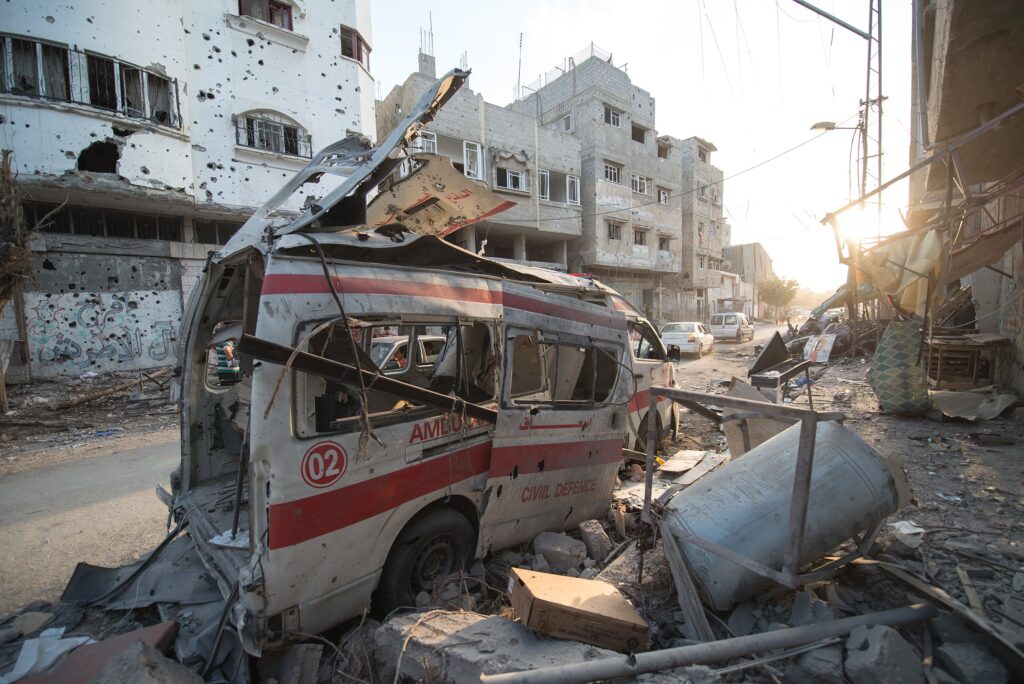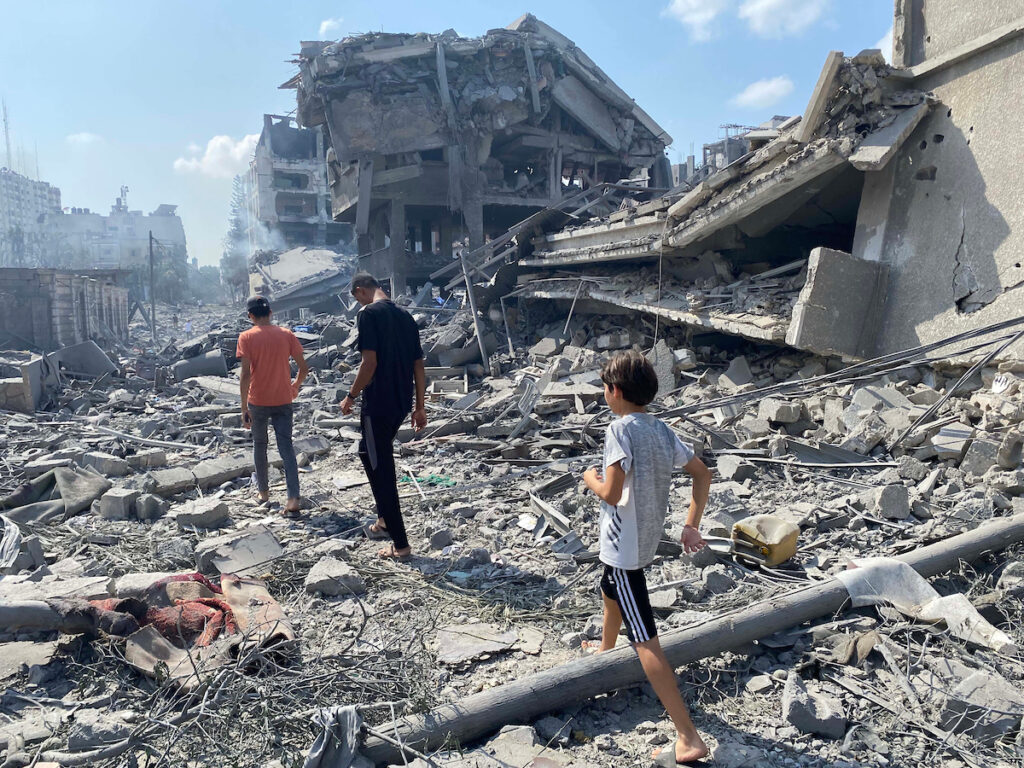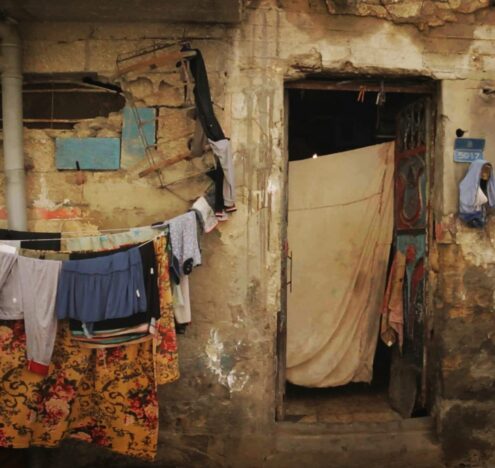During the thick of summer, around 8 a.m. one day in late July 1971, bulldozers crept into the Gaza Strip’s Jabalia refugee camp. The Israeli military had already warned several families of their impending evictions, and a large show of Israeli forces gathered to confront any potential resistance. Soldiers stormed homes Palestinian families refused to evacuate, clubbing them with sticks and batons, and dragging them out into the morning heat. Within a few days, the bulldozers had leveled around 50 homes on the edge of the camp. Some 500 people, refugee families who had already lost their homes elsewhere in historic Palestine some 23 years earlier, were now homeless once again. Another week passed and the number of homes Israeli forces destroyed swelled to 400.
In public, the military said it intended to build wide access roads in the vicinity of several refugee camps. Yet, in private, then General Ariel Sharon, who oversaw the demolitions and would go on to serve as Israeli prime minister, had a plan to “get rid of the Palestinian refugee camps altogether,” he later boasted in his autobiography. “It would be to our great advantage to eliminate [the camps] once and for all, and I believed it was quite feasible.”

Later that year, when the military finished carrying out Sharon’s mass demolitions, it had destroyed the homes of nearly 16,000 Palestinians from the Jabalia, Shati, and Rafah refugee camps, according to a report by the United Nations agency for Palestine refugees, UNRWA, published in 1977. Despite promises to the contrary, the agency noted, Israel had provided around 0.026% of the doubly displaced families alternative housing throughout the six years that followed.
The evictions and demolitions marked a moment that uprisings, wars, massacres, and widespread forced displacements have largely overshadowed since. But when the bulldozers tore through refugee camps in 1971, it was part of a process of attacking and re-dispossessing refugees that has continued at a breakneck pace across decades.
Annexation as Policy
Established more than two decades earlier, Jabalia was initially home to some 35,000 refugees Zionist militias and Israeli forces had driven from southern Palestine before, during, and after the 1948 war. Known to Palestinians as the Nakba, or “the catastrophe,” that war led to Israel’s establishment on some 78% of historic Palestine and scattered hundreds of thousands of Palestinians across the map of the Middle East. Before the war, some 60,000 to 80,000 Palestinians resided in Gaza, but the mass displacement of 1948 swelled the population to around 200,000. Between 1948 and 1952, eight refugee camps were built in the Strip.
Starting in 1949, Egypt controlled Gaza under military rule, and throughout the period that followed, many among the refugee population joined the ranks of a guerilla movement — the fedayeen, many of whom were refugees — that kept Israeli forces busy. In Gaza, resistance rarely took rest, and the fedayeen fighters launched cross-boundary raids that often ended with the killing of Israelis.
Israel cited this militant pushback as one of the reasons for invading and occupying Gaza and the Sinai in 1956 during the Suez crisis. On Nov. 3, 1956, Israeli forces entered Khan Younis, home to an eponymous refugee camp. Many refugees joined the push to rebuff the invasion. Throughout the fighting, Israeli troops killed around 275 people, the UN later estimated — more than half were refugees.
The Khan Younis camp wasn’t the only one to take heavy losses. On Nov. 12, Israeli troops using loudspeakers demanded that the Rafah camp’s male population gather for screening. Amid the chaos that followed, a UN report later put it, “a large number of refugees ran toward the screening points for fear of being late, and some Israel soldiers apparently panicked and opened fire on this running crowd.” The gunfire killed an estimated 111 people, including 103 refugees. Israel only withdrew its forces from Gaza and the Sinai under American and Soviet pressure in 1957, restoring Egyptian control.
By the summer of 1967, Palestinians in dozens of camps in Gaza, the West Bank, Syria, Lebanon, and Jordan had already spent nearly two decades amid the cruel hardships of poverty and exile.
By the summer of 1967, Palestinians in dozens of camps in Gaza, the West Bank, Syria, Lebanon, and Jordan had already spent nearly two decades amid the cruel hardships of poverty and exile. Yet, the soil was tilled to worsen. In June 1967, Israel launched what it calls the Six-Day War and what Palestinians describe as the Naksa, or “the setback.” Israel has long cultivated an image of that war as a “preemptive” effort against Arab armies ready to attack, but many historians and academics, including the Israeli scholar Ilan Pappe, have disputed that characterization. That June 5, at the time Israel launched its attack, a US-led diplomatic push was already underway, Pappe has pointed out. “There was no intention in the Israeli cabinet of providing the necessary time to the peace brokers,” he wrote. “This was a golden opportunity not to be missed.”
For the Arab armies and the Palestinians, the defeat was devastating. During the fighting, Israeli forces turned hundreds of thousands more Palestinians into refugees, razed a slate of villages, and most catastrophically, occupied the Syrian Golan Heights, the Egyptian Sinai, Gaza, and the West Bank, including East Jerusalem. In short, Tel Aviv now controlled the entirety of historic Palestine, and within days of seizing these new territories, Israeli cabinet members hatched plans to indefinitely retain control of and annex Gaza and the West Bank, including East Jerusalem. At a press conference that July, Moshe Dayan, then the Israeli defense minister, insisted that “the Gaza Strip is part of Israel,” a statement he also applied to the West Bank.
A spokesperson for the Israeli UN delegation at the time disputed Dayan’s comments, but official annexation or not, Tel Aviv now found itself facing a conundrum: Millions more Palestinians now lived on the lands it controlled. For its part, densely populated Gaza, as today, presented an especially potent challenge to its occupiers.
Despite those challenges, Israel had every intention to treat the newly occupied territory as its own. In the early years following the 1967 war, Israeli settlements — colonies considered illegal under international law — had already begun to dot the West Bank, including East Jerusalem, as well as the Sinai and the Golan Heights. The first settlement in Gaza came up in 1970 as a military outpost. Throughout the 1970s, Israeli Ministry of Tourism maps showed both Gaza and the West Bank as uninterrupted parts of the country, indistinguishable from Tel Aviv or Haifa.
A History of Attacks on Refugee Camps
To Sharon and others, the existence of camps likely exposed the falsehood of the talking point at the heart of early Zionist propaganda — that a people without a land would supposedly reclaim a land without people. And Sharon’s attacks on refugees stretched far beyond Gaza.
In 1982, Sharon, then serving as defense minister, oversaw the invasion of Lebanon, a deadly attempt to uproot the Palestine Liberation Organization from its strongholds within the country. That war succeeded in forcing the PLO to flee Lebanon for Tunisia, but the legacy of Israel’s invasion centers almost entirely on a three-day massacre: the slaughter in the Sabra and Shatila refugee camps in Beirut. Less than four decades after they fled the Nakba, refugees in the camp faced widespread murder at the hands of militiamen from the right-wing Christian party Lebanese Forces and their allies. Posted outside the camp, Israeli soldiers blocked the exits and shot flares into the night sky while the militiamen killed anywhere between several hundred and a few thousand refugees.
Yet, so long as camps continued to exist, they would continue to give birth to resistance, both figuratively and literally. The Nakba had displaced future Hamas cofounder Ahmed Yassin to the Shati camp in 1948. Islamic Jihad cofounder Fathi Shaqaqi was born in Rafah camp in 1951. Present-day Hamas leader Yahya Sinwar was born in the Khan Younis camp in 1962.
In December 1987, the first Palestinian intifada erupted in Jabalia after an Israeli truck driver crashed into a car, killing four Palestinian civilians. What followed was nearly six years of mass unrest, during which Hamas also emerged as a major political force in Palestinian society. Protesters mobilized, and unions held strikes. Tires went up in flames, and barricades dotted the roads. Youth hurled stones and Molotov cocktails. Israel responded with violence so intense that it earned then defense minister Yitzhak Rabin the nickname “the bone crusher.” It was no coincidence that the uprising began in a refugee camp, born among people forced into exile and doomed to pass their dispossession on to future generations.

The first intifada led to the Oslo Accords in 1993, the negotiations ostensibly meant to establish a Palestinian state on the territories Israel had occupied during the 1967 war. But despite those agreements, Israeli settlements continued to expand across the territories, displacing yet more Palestinians, and the threat of another uprising loomed.
Between 2000 and 2005, during the second intifada, Jenin camp in the northern West Bank earned a reputation for especially fierce resistance in the face of an Israeli effort to effectively erase it. From the earliest days of the uprising, the camps had provided a steady stream of militants, some of whom carried out suicide bombings inside present-day Israel.
In April 2002, Israeli forces invaded Jenin camp and other areas under the Palestinian Authority’s control. Rather than quell militancy, the incursion sparked what became known as the “Battle of Jenin.” For 11 days, tank shells, helicopter-fired missiles, and house-to-house fighting turned what had been a camp home to thousands of Palestinians into the site of a mass destruction. Nearly two dozen Israeli soldiers died, and according to the UN, 52 Palestinians were killed. When Israeli soldiers pulled out, they left the camp in ruins, most of its infrastructure decimated, and at least 140 homes completely destroyed, according to a tally Human Rights Watch later conducted.
Meanwhile, in Gaza, resistance became so fierce during the second intifada that Ariel Sharon, who had become prime minister, eventually ordered the evacuation of the very settlements he had spent decades advocating for in the Strip. In August and September of 2005, Israeli security forces withdrew from Gaza and settlements in the territory were dismantled.
After Hamas won the 2006 legislative elections, Palestinian Authority President Mahmoud Abbas’s Fatah party received US backing to retain control. The following year, Hamas and Fatah went to war against one another in Gaza, and although the Fatah-dominated PA held onto the West Bank, Hamas walked away with control of the Strip. In response, Israel and Egypt imposed a suffocating blockade on the territory, choking it off from the rest of the world. Still in place today, that blockade has put immense strain on the Strip’s majority refugee population: chipping away at humanitarian services, regulating who and what can enter and exit the territory, and leaving residents to face chronic food, fuel, and power shortages.
Gaza Wars
Attacks on the very people Israel’s establishment had already rendered refugees were not new when Israel dispatched bulldozers to the Jabalia camp in 1971, nor have they ceased. Israel has never officially defined the entirety of its borders — then as now, the story of Palestine is one of drawing and redrawing boundaries over the indigenous people. Jabalia is one of dozens of camps across the occupied Palestinian territory and neighboring countries, but when Israeli soldiers yanked women and children into the streets during the summer of 1971 so that bulldozers could flatten homes and make space for access roads, it was one chapter in a decades-long process of dispossession targeting refugees — one that started in 1948 and has raced forward ever since.
Since December 2008, Israel has waged five wars on Gaza. More than 80% of the Strip’s population are refugees, people either displaced in 1948 or the descendants of those who fled to Gaza as the Nakba uprooted hundreds of thousands. Through each of those wars, Israel has racked up allegations of war crimes against refugees and the broader population. While Palestinian armed groups have also faced similar accusations of war crimes, the death toll since 2008 underscores a stark gap: As of last November, conflicts between the two sides had killed some 18,600 Palestinians, while around 1,500 people in Israel were killed during the same period, according to UN data.
Take, for example, what happened in early January 2009, as Israel pressed forward with its first full-scale military operation against Gaza, known as Operation Cast Lead. Israeli tanks fired shells at a UN school in Jabalia, tearing through bystanders and killing at least 40 people. Throughout the eight-day war in 2012, Israel bombed a police station in Jabalia, damaging a UN-run distribution center and a clinic for refugees.

In 2014, Israel went to war in Gaza yet again, this time for 51 days. The camps endured heavy civilian casualties. Early on in that war, the deadliest up until that point, one incident made headlines the world over. On July 16, four young boys, all cousins from the extended Bakr family, left their homes in the Shati refugee camp to play on the beach. Israeli naval forces launched the missiles that killed all four. Two weeks later, another tragedy rocked a camp: in Jabalia, an Israeli attack on a UN school where refugees had sheltered killed at least 15 and injured dozens more. UNRWA spokesperson Chris Gunness said after the incident, “The world stands disgraced.”
In 2021, when Israel and Gaza-based armed groups went to war for 11 days, refugee camps once again were not spared. One of the deadliest Israeli attacks of the war took place in the Shati camp. An airstrike hit a home in the camp and killed 10 members of a single family — eight of the slain were children, and the sole survivor was an infant.
Deadliest War Yet
Since Oct. 7, 2023, Israel has been engaged in its deadliest war yet in Gaza. After Hamas-led fighters stormed southern Israel and killed some 1,200 people in a deadly surprise attack, Israel launched a fresh military assault by land, sea, and air. By the end of that year, more than 1.9 million Palestinians in Gaza were displaced and north of a quarter-million homes were destroyed, according to the Norwegian Refugee Council. That number has continued to swell since. In May, the UN predicted that it could take up to 80 years to rebuild all the homes destroyed in Gaza. Throughout the fighting, many of those whom Israel’s incursion into northern Gaza displaced to the southern part of the Strip have been uprooted time and again.
The camps, as one might expect, have suffered alongside towns and villages up and down the Strip. In July, the Gaza-based government’s media office said Israeli forces had bombarded the Nuseirat refugee camp some 63 times in a single week. That string of attacks killed at least 91 people and left the majority of the 251 injured residents “with burns due to Israel’s use of thermal and chemical weapons,” the media office said in a statement.

For its part, the violence has exacted an especially deadly toll on the Jabalia camp. Even when there isn’t war, life in the camp is plagued by severe overcrowding, electricity shortages, and a contaminated water supply, among other problems. But now, little is left standing. Just two days into the current war, an Israeli airstrike hit a market in the camp, killing dozens. On Oct. 12, another attack struck a residential home in the camp, taking the lives of some 45 people. Two and a half weeks later, Israeli jets bombarded the camp once again — Iyad al-Bazum, a spokesperson for Gaza’s interior ministry, later said the attacks left Jabalia “completely destroyed.” In December, a barrage of Israeli attacks killed at least 90 people, the health ministry said at the time.
Meanwhile, reports of mass graves have become routine across the Strip. As for the death toll, who can say with any precision? Gaza’s health ministry estimates more than 42,000 have been killed, but counting the dead can prove a challenging, if not impossible, task so long as the bombs continue to fall. According to an analysis in The Lancet medical journal in July, even if a ceasefire went into effect at the time, the number of deaths could climb to as high as 186,000.
Yet, as with all conflicts, death tolls only tell part of the story. In June, Palestinian authorities declared the entirety of Jabalia — not just the camp — and nearby Beit Hanoon “disaster areas.” Across the northern part of the Strip, Israel had already bulldozed more than 50,000 housing units and destroyed large tracts of drainage networks and roads.
No End in Sight
A year into this latest war, Israel shows no sign of letting up. In late June, Israeli Prime Minister Benjamin Netanyahu, who oversees the country’s far-right government, insisted he wouldn’t agree to any deal that ended the military offensive on Gaza. Israel has responded to international pressure with plans to build new settlements in East Jerusalem and the West Bank, and far-right groups have launched a push to resettle Gaza. More alarming still, reports leaked that Israel’s intelligence ministry had drafted a concept paper — dated Oct. 13, a week into the current war — that proposed the mass transfer of Gaza residents to tent cities in Egypt’s Sinai.
Meanwhile, Israel has poured kerosene on simmering tensions along the country’s border with Lebanon. As the Lebanese group Hezbollah and other armed outfits fired rockets into present-day Israel, Israeli forces set about bombing villages up and down the line, carrying out airstrikes in Beirut, killing dozens and injuring thousands (among them civilians) by detonating explosive-laden pagers and walkie talkies as part of an attack on the Lebanese armed group Hezbollah. Last month, Israeli airstrikes killed Hezbollah Secretary General Hassan Nasrallah. As Israel escalates attacks across Lebanon, Netanyahu has insisted that the war is against Hezbollah and not the Lebanese people. Meanwhile, Israeli attacks killed more than 1,000 people in Lebanon in less than two weeks, displaced a million others, and hit homes, apartment buildings, and refugee camps from the southern border to the northern city of Tripoli.
In the week leading up to the one-year mark since the war started, Israel launched deadly attacks on Jabalia and issued evacuation warnings to Palestinians in the Nuseirat camp, while carrying out airstrikes on the Tulkarem refugee camp as well as Lebanon’s Beddawi and Ain al-Hilweh camps.

Even as Israel sends ground forces into Lebanon, the violence in Gaza presses forward. Four decades after Ariel Sharon dispatched bulldozers to the Jabalia camp, once the largest and most populated in Gaza, vast mounds of rubble have replaced the tight rows of homes that once housed generations of people waiting to return to the houses and lands they lost in 1948. Before the current war, the camp was home to some 119,000 registered residents. Yet, as far back as February, a resident told Al Jazeera Arabic reporter Anas al-Sharif “not a single [in]habitable house” remained in Jabalia. That was eight months ago. Whether Jabalia will cease to exist — whether any city, village, or camp across Gaza will survive — is a real concern.
In 2012, the UN published a report that warned that Gaza could become unlivable within eight years. At the time, the Strip’s population was an estimated 1.6 million, and the report predicted that by 2020, safe drinking water, quality education and healthcare, and affordable and stable electricity “all will have become a distant memory for most.” Since then, 2020 came and went, the population has topped two million, and Israel has carried out three more wars on the territory. The current war has now passed the one-year mark, and 90% of the Strip’s population is internally displaced or has fled to other countries. What will we call Gaza after this? Will unlivable do it justice? Does the right word even exist?
Top photo: A photograph shows the aftermath of an airstrike in the Gaza Strip, published on Aug. 14, 2022 (Mohammed Ibrahim/Unsplash)




















